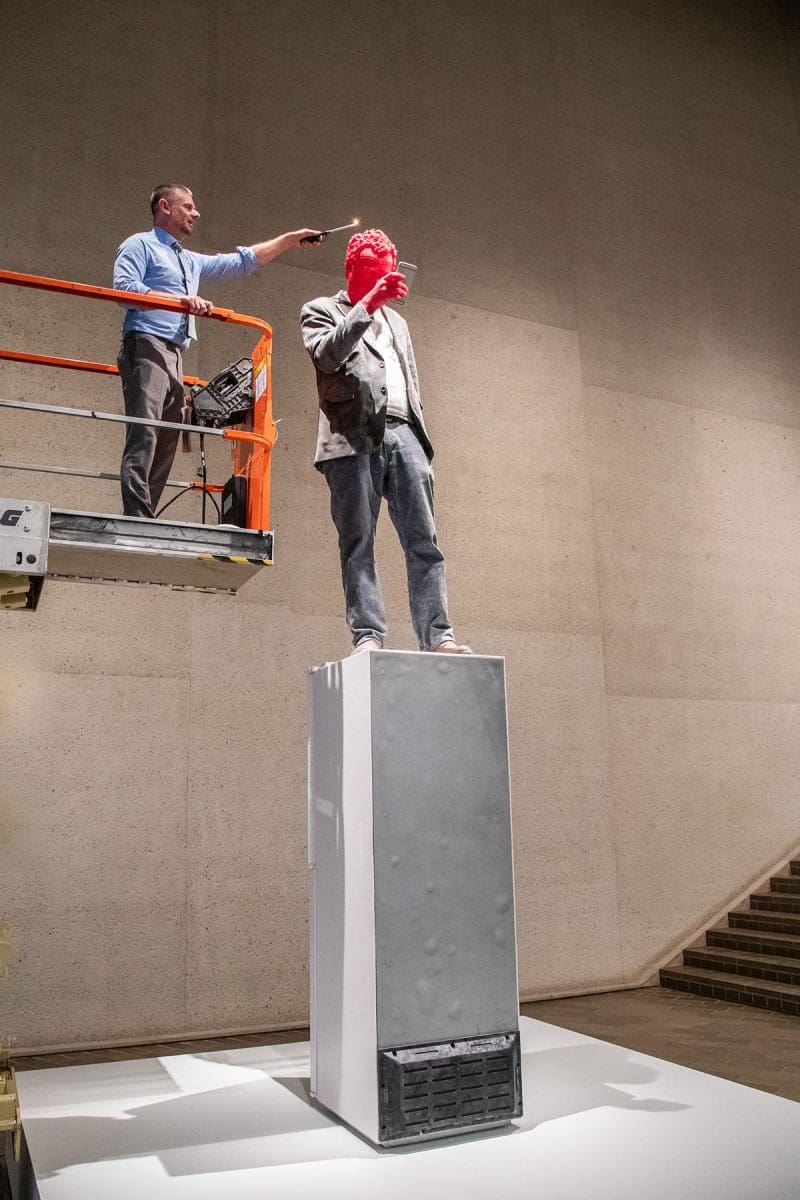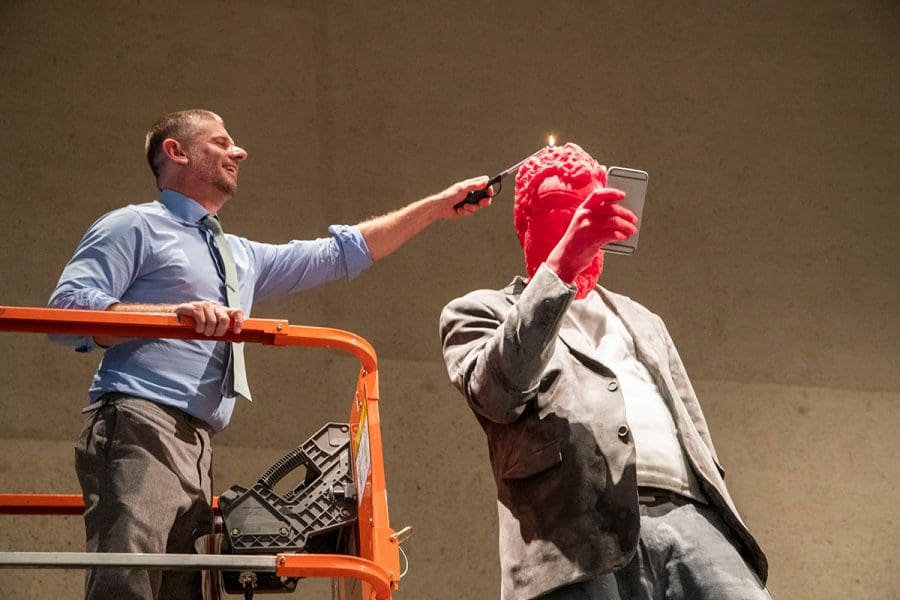
Making Space at the Table
NAP Contemporary’s group show, The Elephant Table, platforms six artists and voices—creating chaos, connection and conversation.





In March 2019, the National Gallery of Australia (NGA) acquired Urs Fischer’s four-metre red wax sculpture, Francesco, 2017, for their permanent collection. With wicks running through its wax frame, Francesco is designed to be lit and slowly melted like a candle. Documenting Francesco’s decomposition via social media, the NGA recently conducted an #askacurator Instagram session, inviting the public to ask questions about Fischer’s wax figures. Briony Downes spoke to Jaklyn Babington, senior curator of contemporary art at the NGA, to find out more about Francesco and how museums are using social media to spark conversation about contemporary art.
Briony Downes: Urs Fischer has been making figurative wax sculptures since the early 2000s. Can you elaborate on who Francesco is and how the NGA engages with the performative aspects of a work made to deteriorate?
Jaklyn Babington: Francesco is a portrait of Italian curator Francesco Bonami, a friend of Urs Fischer and someone with whom he has worked for many years. Francesco is one of Fischer’s most recent ‘candle’ sculptures and is largely comprised of microcrystalline wax, paraffin wax and pigment.

Francesco depicts a figure who stands, slouched, on top of a stocked refrigerator, peering down at his smart phone. The sculpture’s various components – the figure, refrigerator and the fruit and vegetables are all made of wax. The detail is striking, the vegetables – in particular, the broccoli and the mushrooms – are truly exquisite objects.
It is a ‘choreographed’ sculpture containing three candle wicks which are expertly drilled and placed within the sculpture by the NGA’s conservator and installations team. The sculpture is lit each morning and extinguished each evening, and in this way, will burn at the NGA for a period of five months.
Following the instructions of the artist, we will only burn the figure of Francesco. His final remains will be cleaned up, with any surviving components retained by the NGA, and any melted components to be recast by the artist’s studio.
BD: The process of decay and regeneration are key themes in Fischer’s practice. What is the artist saying with this work?
JB: Francesco is about many things. With Francesco, Fischer is exploring entropy conceptually as well as physically. It is interesting to learn that entropy is the redistribution of energy in a material (such as wax) as it transforms from one state to another under heat.
Fischer has stated that the way Francesco is looking down at his phone is the pose he immediately associates with Bonami, who he sees as an ‘always working’ kind of curator. However, it is also a pose immediately associated with the time we live in, a pose emblematic of day-to-day activities in the 21st century.
With this ‘everydayness,’ we get to the crux of the artist’s intent: to create an anti-monument monument.
Francesco is a sculpture of a man, unknown to many and depicted casually, standing not on a plinth but a refrigerator. It’s laughable for its absurdity, but despite its apparent random associations, it is a highly memorable composition. Fischer is quite brilliant in this way.
BD: There were some really entertaining questions on the recent #askacurator session, like “Is Francesco scented?” and “How will the NGA preserve his remains?” Have you found #askacurator to be an effective way of engaging with the public?
JB: The #askacurator session was a fantastic way to discuss the work in more detail; #askacurator allows the audience to ask questions that are perhaps left of centre from the usual questions we might discuss as curators in an art gallery. It’s a bit like an ‘on demand’ art conversation, led by the audience.
Many people wanted to understand how the sculpture works durationally. Fischer’s great skill is in creating art that playfully explores life’s universal questions. All of us wonder about how our world works and wonder about ourselves in relation to time. I really enjoyed the session, and given the response, I think the NGA’s Instagram followers did too.
BD: Do you think a social media format like #askacurator leads to a greater appreciation of art?
JB: Social media is a valuable portal to information. The greatest function is obviously its accessibility: the anywhere, anytime exploration of interesting subjects. I think this increased access generates a greater curiosity, and in turn, curiosity leads to deeper investigation and appreciation of art.
It’s a way of providing access to the national collection beyond the walls of the NGA. Character limits are not a hindrance and questions from our audience have been precise, fun, short and long, and fostered fantastic discussion.
BD: Would you say interest in Francesco has increased because of his social media presence?
JB: Francesco has been an instant hit with our audience at the NGA and online. The sculpture has generated its own followers, and even a few very enthusiastic fans who have tried to emulate his pose by taking photographs of themselves standing on a bar-fridge in their backyards.
BD: One of the most recent NGA Instagram posts reveals Francesco has lost his head, with wax cascading down his shirt front. In terms of collecting a materially impermanent work like Francesco, how do you go about archiving its existence and making it a tangible part of the NGA collection?
JB: Francesco is in a continuous cycle of melting and recasting. Once the figure melts, the NGA will decide when the work should be recast, and subsequently re-performed and melted again. This is because in acquiring Francesco, the NGA also acquired the ability to have the work recast by the artist’s studio.
This recasting process will continue as long as the NGA wants the work to be recast and as long as the studio can recast the work. In the future, if the studio is unable to recast, the NGA have the A-crystal positive moulding for Francesco to be recast by an approved foundry, precisely following instructions set by the artist and his studio.
In addition to this, the NGA’s team of installation, exhibition, conservation and imaging staff are documenting and recording Francesco’s life and death in detail. Our videographers are capturing every drip of molten wax with a time-lapse video that will be publicly available on the NGA website once complete. It will be a fantastic document for everyone to view.
Francesco
Urs Fischer
National Gallery of Australia
December 2019 onwards